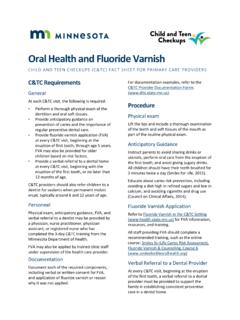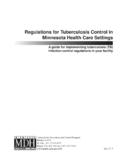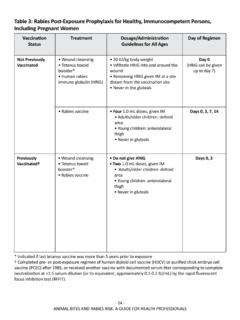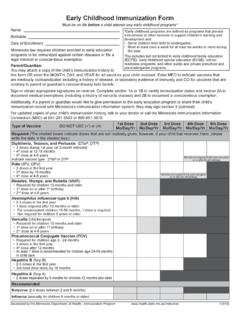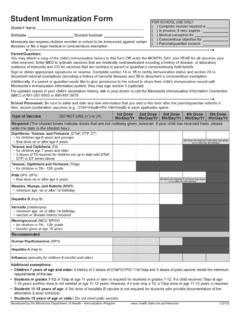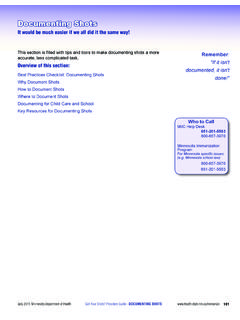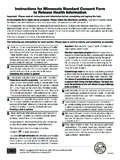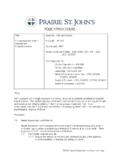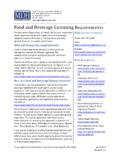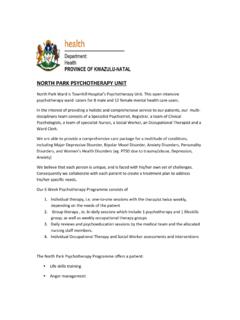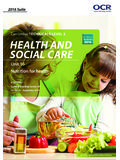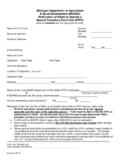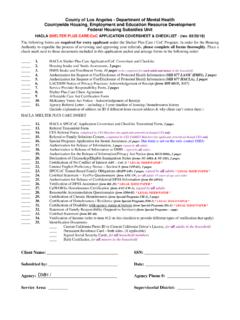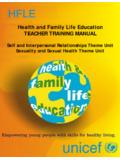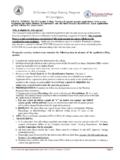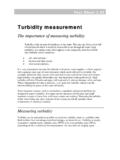Transcription of Home Safety Checklist - Minnesota Department of …
1 home Safety Checklist Do you know how safe your home is for your baby or young children? Use this Checklist to help spot what parts of your home are safe and where you can make it safer. Safe Sleep o Is your baby always placed on his/her back to sleep? o Is your baby sleeping alone in a crib-type bed for nighttime and naps at home and away from home ? o Have you checked your baby s bed to make sure the crib sides are stationary and there are no broken or missing crib slats? Crib slats must be no more than 2 3/8 inches apart. o Is the crib mattress firm and fitted snugly inside the crib (no extra room around edges)? o Is your baby s crib empty of pillows, comforters, stuffed toys, bumper pads, and other soft items? Bathroom o When your child is in the bathtub, is an adult always present? o Is your hot water heater set to never go up over 120 degrees Fahrenheit? o When you run your child s bathwater, do you test the temperature first with your wrist or elbow?
2 O Are there non-skid strips or a mat on the bottom of the bathtub? Safe Storage o Are there Safety latches or locks on cabinets and drawers that contain potentially dangerous items? o These items include: o Vitamins o Cigarettes o Tobacco products such as e-juice or e-cigarettes o Plastic bags o Matches and lighters o Knives, scissors, razor blades and other sharp objects o Cleaning supplies, pesticides and other poisonous materials-keep those in their original containers o Guns and ammunition-must be stored separately o Medications- including over the counter medicines o Energy drinks and alcoholic beverages o Remember: child resistant packaging is not child-proof Kitchen o Are small appliances in the kitchen (coffee maker, toaster) and bathroom (hair drier, curling iron) unplugged and put away? If they cannot be stored in a cabinet or drawer, push them to the back of the counter. o Are the back burners on the stovetop used for cooking?
3 O Are pot handles turned toward the back of the stove? Around the house o Are the poison control phone number (Answered 24/7: American Association of Poison Control Centers: 1-800-222-1222) and other emergency contacts posted near all of your phone or in an obvious place in the home ? It is not necessary to keep syrup of ipecac in your home . In case of poisoning, always call the poison control number and the experts there will advise you on what to do. o Are small toys and objects that your baby could choke on out of reach and picked up off the floor? It is important that objects containing button batteries (TV remote, clocks) have screw-secured batteries covers and toys with small magnets are out of reach. o Are working carbon monoxide detectors installed within 10 feet of each room used for sleeping? Carbon monoxide detectors should be tested monthly and the batteries changed every year. o Are working smoke detectors placed in each sleeping room as well as the hallways outside of the sleeping rooms?
4 Smoke detectors should be tested monthly and the batteries changed every year. o Is everyone living in your home aware of an emergency exit plan in case of fire? o Is your home smoke-free (no one smokes inside your home )? o Are heavy or unstable pieces of furniture, such as TV s entertainment centers, and bookshelves, anchored to the floor or secured to the wall? o Are Safety /baby gates installed at the top and bottoms of all stairs? o Are stationary activity centers used instead of infant walkers? o Are the windows in your house or apartment child-safe? Things to do: o Move furniture away from windows o Keep windows especially those reachable by children locked or have window guards or stops to prevent them from being open more than 4 inches o Are electrical cords in good condition (not frayed)? o Are there shock prevention plugs or covers on all unused electrical outlets? o Are you keeping your child safe from lead poisoning?
5 O Peeling paint or paint dust on walls and windows can have lead if your home was built before 1978. o Certain folk remedies may contain lead o Are the cords from windows, blinds, draperies or baby monitors out of your child s reach? If cords for blinds or draperies are looped, but them to create two short cords. In the car o Are age-appropriate child Safety seats properly installed and used when children are riding in a motor vehicle? o Does everyone wear seat belts (or ride in an age-appropriate, properly installed child Safety seat) while riding in motor vehicles? Created by the Minnesota Department of Health/Community & Family Health Division/Maternal & Child Health Section/ Family home Visiting Unit, Minnesota Department of Health: Family home Visiting website Box 64882, St. Paul, MN 55164, Phone: 651-201-3760, Fax: 651-201-3590. Created: 12/2012. A corresponding home Safety Reference Guide for professionals is posted on our website.
6
